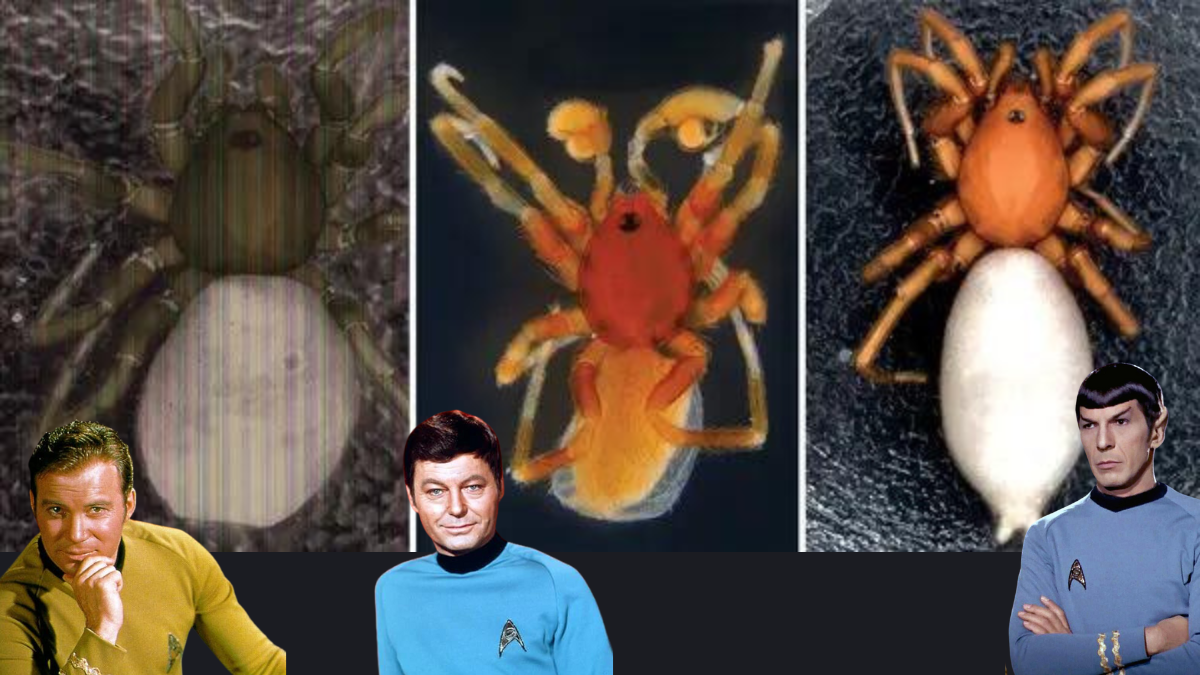SCIENCE: Hide Your Curds and Whey. These Newly-Discovered Spiders Are Named After Iconic 'Star Trek' Characters!

L to R: The newly discovered Kirk, McCoy, and Spock spiders.
SEPTEMBER 15, 2023 - In a discovery that is sure to excite both arachnid enthusiasts and pop culture aficionados alike, a new genus of spider has been identified and named after some of the most beloved characters from the iconic Star Trek series. Meet the Roddenberryus genus, a fascinating addition to the world of nopine spiders.
The Roddenberryus genus, named for Star Trek creator Gene Roddenberry, encompasses five distinct species. The discovery was made by a team of researchers led by Alexander Sánchez-Ruiz and Alexandre B. Bonaldo who published their findings in the European Journal of Taxonomy.
The three newly discovered species include R. kirk, named after the charismatic Captain James T. Kirk from Star Trek, with separate male and female specimens found in Costa Rica. Then there's R. spock, a nod to the enigmatic Mr. Spock, identified as a female from Campeche, Mexico. Finally, there's R. mccoy, named after the gruff but lovable Dr. Leonard "Bones" McCoy, discovered as a male in Baja California Sur, Mexico.
But the discoveries didn't stop there. Two species that were previously misclassified in the Caponina Simon genus have found their true home in the Roddenberryus genus. R. sargi, originally described in 1899 from Guatemala, and R. pelegrina, initially identified in 1940 from Cuba, are now officially recognized members of the Roddenberryus family.
One of the most intriguing aspects of this discovery is the reclassification of a male specimen originally reported as C. sargi by E. Kritscher in 1957 from Costa Rica. This spider has been reassigned to Roddenberryus kirk, along with a female specimen collected at the same location. It seems that even in the world of arachnology, there can be some mix-ups that require a keen eye to rectify.
The Roddenberryus genus stands out in the world of spiders due to several distinctive characteristics. These include distally projected endites and a triangular, projected labium, a feature not found in any other nopine spiders. Additionally, the genus boasts a triangular, very short, scaly gladius, a serrula with interspersed multiple tooth rows, and a tarsal organ with strongly projected margins. These unique attributes set Roddenberryus apart from its arachnid relatives.
Intriguingly, Roddenberryus shares some features with the Tarsonops Chamberlin genus, including cracked tarsi and metatarsi, with multiple adesmatic joints intertwined on the cuticle. Another unusual similarity is their internal respiratory system, where both posterior tracheae fuse into a single trunk. These shared characteristics provide further insight into the evolutionary connections among these fascinating spiders.
The discovery of the Roddenberryus genus adds a dash of sci-fi flair to the world of arachnology, celebrating the enduring influence of the Star Trek series and its beloved characters. As scientists continue to explore the mysteries of our natural world, it's heartening to see a touch of pop culture making its mark in unexpected places. Whether you're a fan of spiders or Star Trek, this discovery is a testament to the power of science to boldly go where no one has gone before.
Thanks to DSTN reader Malavika Sasikumar for letting us know about this story. If you have a lead on something you think we should report on, let us know at info@dailystartreknews.com.
Chris Post is a life-long fan of Star Trek who has been working in journalism for nearly 25 years.





